Analog continuous time statistical processing
a statistical processing and analog technology, applied in the field of signal processing, can solve the problems of difficult to avoid explicitly handling analog signal attributes, and achieve the effect of avoiding power usage and increasing processing speed
- Summary
- Abstract
- Description
- Claims
- Application Information
AI Technical Summary
Benefits of technology
Problems solved by technology
Method used
Image
Examples
Embodiment Construction
[0031]The sum-product algorithm (also known as the “belief propagation” algorithm) and its approximations (such as max-product) operate by message passing on a probabilistic graphical model (PGM). A growing number of statistical signal processing algorithms have been shown to be special cases of the sum-product algorithm on a particular PGM. Decoding algorithms, for example, can be described as Bayesian networks using sum-products. Sum product algorithms consist of a series of addition and / or multiplication steps.
[0032]Given a function with a discrete number of potential outcomes, a probability function P(X), where X denotes the set of possible outcomes {x1, . . . , xm} can be defined such that ΣP(X=xi)=1. The probability, therefore, that P(X=xi) (which can be denoted as Px(xi)) for each xi ranges from 0 to 1 (assuming non-negative probabilities). Such a function can be modeled in circuit form by representing probabilities as percentages of a maximum current Ix, i.e., Ix,i=IxPx(xi) ...
PUM
 Login to View More
Login to View More Abstract
Description
Claims
Application Information
 Login to View More
Login to View More - R&D
- Intellectual Property
- Life Sciences
- Materials
- Tech Scout
- Unparalleled Data Quality
- Higher Quality Content
- 60% Fewer Hallucinations
Browse by: Latest US Patents, China's latest patents, Technical Efficacy Thesaurus, Application Domain, Technology Topic, Popular Technical Reports.
© 2025 PatSnap. All rights reserved.Legal|Privacy policy|Modern Slavery Act Transparency Statement|Sitemap|About US| Contact US: help@patsnap.com



